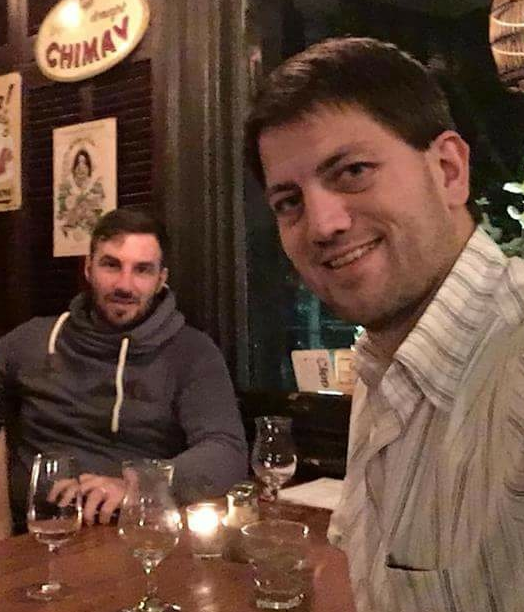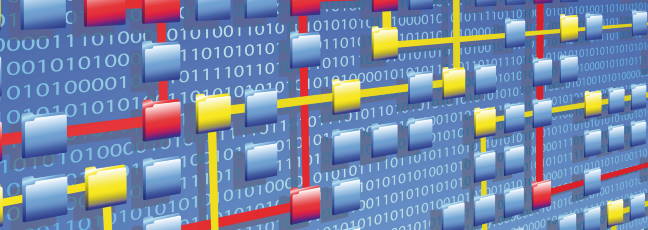Exploring newland: Blockchains and process mining
exploring newlandTalking with Jan Mendling and Ingo Weber
Process mining is extending the scope of its analysis toward blockchains. Thus, we have a chat with the initiators of this exploration at the crossroads between blockchain and business process management: Ingo Weber (in the following, IW) and Jan Mendling (JM).
Tell us a bit about yourselves and your research institutes!

JM: I am a little bit older, so let me start. After working with QUT Brisbane and HU Berlin, I returned to WU Vienna in 2011 as a full professor. Our BPM team researches business process related topics including automation, mining, innovation and modeling. I also contribute to WU’s Institute for Cryptoeconomics since blockchains facilitate new inter-organizational process coordination.
IW: Sure, age before beauty ;-) After my PhD in Karlsruhe, I went to Australia and spent 10 years in Sydney where I first worked at UNSW and then at NICTA and then CSIRO. Last year, I came back to Europe, as a full professor at TU Berlin. My new group is still in the formation stage, but both Blockchain and BPM / process mining will stay high up on the agenda.
When and why did you first come up with the idea to do research in process mining?
IW: When I was a first-year PhD student in 2006, I attended a talk Wil gave, and the usefulness and appeal of the technology immediately became apparent to me. Unfortunately, I did not manage to work on the topic until 2013, when I applied process mining to challenges in cloud dependability (see http://ts.data61.csiro.au/publications/nictaabstracts/Xu_ZWBS_14.abstract.pml and http://ts.data61.csiro.au/publications/nictaabstracts/Weber_RLM_15.abstract.pml).
JM: I came in touch with process mining when I was a visiting researcher in Wil’s group in 2006. My first process mining papers are from 2009 together with Kerstin Gerke who worked as a PhD student in our team at HU Berlin (see https://doi.org/10.1109/CEC.2009.72 and https://doi.org/10.1007/978-3-642-01190-0_16). Back then, we recognized that the assumption that a single object is flowing through the process is not realistic. Many processes have 1:n and n:m relationships between orders, commissions, transports and invoices. We discussed these problems for supply chain processes and RFID data and proposed solutions for constructing case identifiers and handling n:m relationships.
So, what is the blockchain and how can it be of support for process analysis and mining? And the other way around: how can process mining be of help for blockchain applications?
JM: Very briefly, blockchains offer a way to execute processes in a trustworthy manner over a computer network without any mutual trust between nodes. How do you define it in your book, Ingo?

IW: In summary: A blockchain is an append-only store of transactions which is distributed across many machines, and structured as a linked list of blocks. The value of this technology for many applications, however, comes from smart contracts. These are programs that are stored in transactions, and the useful property is that these can be executed on the neutral ground of a practically tamper-proof and censor-resistant blockchain system.
JM: In our ACM Transactions article from 2018, we describe “risk and opportunity of conducting process mining on blockchain data. An opportunity could involve establishing trust in how a process or a prospective business partner operates, while a risk is that other parties might be able to understand operational characteristics from blockchain transactions. There are also opportunities for reverse-engineering business processes, among others, from smart contracts.” Ingo has some more recent developments to share.
IW: Basically we can expect multi-party applications to increasingly be based on blockchain technology going forward. And, of course, it will be of interest how these applications, and the processes they implement, are being used. Also, because data on the blockchain is tamper-proof, it often forms a source of reliable data which can be used for process mining. However, some difficulties exist around how to interpret and extract the data. We started to address these with our BPM Blockchain Forum paper last year, and were thankful to receive the best paper award for it.
Tell us a bit about the Blockchain Forum at BPM, as an organiser and as an author. How can process mining researchers contribute to the Forum, and how can process mining enthusiasts benefit from attending the event?
JM: We invented this new forum for the BPM Conference 2019 that we organized in Vienna. The BPM community had organized a Dagstuhl seminar on the topic and the BPM and Blockchain research agenda was just published in ACM Transactions on Management Information Systems. Another driver was the increasing local collaboration in Austria around the Austrian Blockchain Center. The BPM Blockchain Forum was a huge success, partially also thanks to Ingo’s keynote reflecting on four years of research and applications and his co-authorship of the best paper.
IW: Thanks for the honor, and for creating this great format! From the viewpoint of an author, I found it a very useful forum. I attended quite a few of the sessions last year, and there were quite lively, high-quality discussions. However, one particularity about blockchain is best summarized in the following 2011 quote by Dan Kaminsky about Bitcoin: “The first five times you think you understand it, you don’t.” So, writing a good paper on the topic requires building a quite good understanding of the underlying tech. That being said, I’m excited to hear: how will you build on the success of the last year?
JM: This year, we continue with another Blockchain Forum at the BPM Conference in Seville. To update the topics, we take into account the suggestions we gathered from the audience last year, based on a poll at the end of the event. Mark 24 May in your calendars as the submission deadline for abstracts, full paper submission one week later!

How do you see the interplay of blockchains & process mining in the future?
JM: It is a great opportunity to develop process mining for blockchains into a direction that some blockchain behaviour can be automatically identified and translated to skeletons of smart contracts.
IW: Great idea! Let me just add that Enterprise-centric blockchain companies talk a lot about multi-party or inter-organizational business processes to be implemented in blockchain applications. Analyzing these will be useful. But process mining can also play a role in analyzing various data; maybe it can be a useful tool for understanding how blockchain apps are used, in line with their intention or otherwise; or maybe for forensics when things go wrong or illegitimate use is detected. Lastly, based on our paper from last year, we proposed a generic logging framework for the Ethereum blockchain -- see https://arxiv.org/abs/2001.10281. The framework is available as open-source software, and given that it can generate XES files, I hope it’ll be very useful to process mining researchers.
Photo on the right courtesy of Ingo Weber: Jan and Ingo discussing research topics over Belgian beer in Sydney.
- Academic stories: Pnina Soffer
- From Research Vision to Startup: The Story of Apromore
- Exploring newland: Blockchains and process mining
- BPI Challenges: 10 years of real-life datasets
- End-user’s corner: Bruna Pereira
- ICPM 2020 goes fully virtual!
- Special Issue on Process Mining and Emerging Applications (MDPI Algorithms journal)
- This article has been updated on May 14 2020, 19:42.
- Talking with Jan Mendling and Ingo Weber

